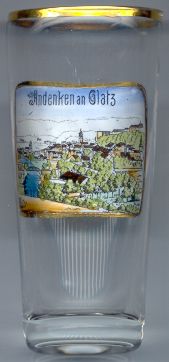

|
| POLSKA | POLAND |
| województwo: Dolnośląskie | voivodship: Lower Silesia |
| powiat: Kłodzko | county: Kłodzko |
 Kłodzko (German: Glatz) is situated at an elevation of 294 m on the river Nysa Kłodzka (Glatzer Neiße)
in the Dolnośląskie (Lower Silesia) region of southern Poland.
The town is the administrative centre of the Kłodzko county (powiat Kłodzki) and has a population of about 30,100 (2003).
Kłodzko (German: Glatz) is situated at an elevation of 294 m on the river Nysa Kłodzka (Glatzer Neiße)
in the Dolnośląskie (Lower Silesia) region of southern Poland.
The town is the administrative centre of the Kłodzko county (powiat Kłodzki) and has a population of about 30,100 (2003).
The area has been inhabited at least since the 1st century BC. The earliest written mention of Cladzco is found in a document of 981, a chronicle of Kosmas of Prague, the first chronicler of Bohemia. Initially in Bohemia, the town was also claimed by Poland and therefore was devastated during a series of conflicts between the two countries at the beginning of the 12th century. With the peace treaty of 1137 all claims to the area of Kłodzko were ceded to Bohemia. The town was chartered on a Magdeburg Law between 1253 and 1278, though the exact date is unknown. In 1278 it was taken over by Duchy of Wrocław, and thus became a Polish province of Silesia. In 1290 it was sold to the Piast Dukes of Świdnica (Schweidnitz) and in 1301 it was sold to Dukes of Ziębice (Münsterberg). However, in 1334 the town was sold back back to Bohemia. The town gained significant profits from its location on the ancient road through mountain passes in the Sudetes. Kłodzko developed rapidly until the times of the Hussite Wars in 15th century. The wars left the town depopulated by plagues, partially burnt and demolished by several consecutive floods. When the Kingdom of Bohemia became part of the Habsburg countries in 1525, the duchy of Kłodzko became a fief of the Habsburg dynasty. However, the local dukes retained their powers. During the Thirty Years' War (1618–1648) Kłodzko was besieged several times. Although the fortress was never conquered, the town itself was severely destroyed. After the war, the Austrian authorities the local self-government and the duchy practically ceased to exist.
During the War of the Austrian Succession (1740–1748) the town changed hands several times, but was finally conquered by Prussia in 1743 and got annexed in 1763. In 1807 the town and fortress were conquered by Napoleon but were returned to Prussia shortly afterwards. A period of fast modernization and expansion began in the late 19th century. Towards the end of the 19th century the whole Kłodzko valley turned into one of the most popular tourist regions among the rich bourgeoisie of Wrocław (Breslau), Berlin, Vienna and Kraków.
During World War II the fortress was changed into a prison, and it soon became one of the most cruel places of
detention in whole Silesia. The town itself was not damaged by the war and was taken over by the Soviet Army without much opposition.
After the war, Silesia was given to Poland and the name of the town was changed from German Glatz to Polish Kłodzko.
Most of the former German inhabitants were expelled and the region was repopulated with Poles expelled from the
eastern Polish territories annexed by the Soviet Union.
In the 1950's and 1960's much of the city centre was damaged by landslides. It turned out that throughout the city's history
whole generations of Kłodzko's merchants developed an extensive net of underground basements and tunnels.
With time the tunnels were forgotten and after World War II many of them started to collapse—together with the houses above.
Since the 1970's the tunnels were conserved and the destruction of the city was stopped.
Currently Kłodzko is one of the most important centres of culture, commerce and tourism in Lower Silesia.
![[scale]](lineal.jpg)